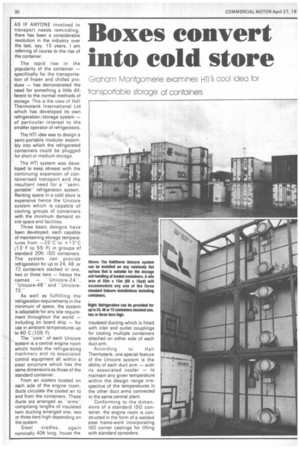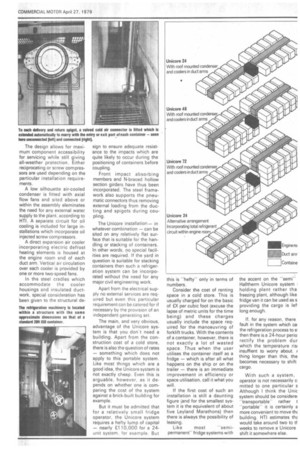Boxes convert into cold store
Page 32

Page 33

If you've noticed an error in this article please click here to report it so we can fix it.
Graham Montgomerie examines HTrs cool idea for transportable storage of containers
AS IF ANYONE involved in transport needs reminding, there has been a considerable revolution in the industry over the last, say, 15 years. I am referring of course to the rise of the container.
The rapid rise in the popularity of the container — specifically for the transportation of frozen and chilled produce — has demonstrated the need for something a little different to the normal methods of storage. This is the view of Hall Thermotank International Ltd which has developed its own refrigeration /storage system — of particular interest to the smaller operator of refrigerators.
The HTI idea was to design a semi-portable modular assembly into which the refrigerated containers could be plugged for short or medium storage.
The HTI system was developed to keep abreast with the continuing expansion of containerised transport and the resultant need for a "sem iportable" refrigeration system. Renting space in a cold store is expensive hence the Unicore system which is capable of cooling groups of containers with the minimum demand on site space and facilities.
Three basic designs have been developed, each capable of maintaining storage temperatures from —25=C to + 13a C (13 F to 55 F) in groups of standard 20ft. ISO containers. The system can provide refrigeration for up to 24, 48 or 72 containers stacked in one, two or three tiers — hence the names — –Unicore-24", "Unicore-48" and "Unicore72."
As well as fulfilling the refrigeration requirements in the minimum of space, the system is adaptable for any site requirement throughout the world — including on board ship — for use in ambient temperatures up to 4Q C(105 F).
The "core" of each Unicore system is a central engine room whieh holds the refrigerating machinery and its associated control equipment all within a steel structure which has the same dimensions as those of the standard container.
From air coolers located on each side of the engine room, ducts circulate the cooled air to and from the containers. These ductsare arranged as "arms" comprising lengths of insulated twin ducting arranged one, two or three tiers high depending on the system.
Steel cradles, again nominally 40ft long, house the insulated ducting which is fitted with inlet and outlet couplings for cooling multiple containers attached on either side of each duct arm.
According to Hall Therrnotank, one special feature of the Unicore system is the ability of each duct arm — with its associated cooler — to maintain any given temperature within the design range irrespective of the temperatures in the other duct, arms connected to the same central plant.
Conforming to the dimensions of a standard ISO container, the engine room is constructed in the form of a welded steel frame-work incorporating ISO corner castings for lifting with standard spreaders. The design allows for maximum component accessibility for servicing while still giving all-weather protection. Either reciprocating or screw corn pressors are used depending on the particular installation requirements.
A low silhouette air-cooled condenser is fitted with axial flow fans and sited above or within the assembly eleminates the need for any external water supply to the plant, according to HT!. A separate circuit for oil cooling is included for large installations which incorporate oil injected screw compressors.
A direct expansion air cooler incorporating electric defrost heating elements is housed at the engine room end of each duct arm. Vertical air circulation over each cooler is provided by one or more two-speed fans.
In the steel cradles which accommodate the cooler housings and insulated ductwork, special consideration has been given to the structural de sign to ensure adequate resistance to the impacts which are quite likely to occur during the positioning of containers before coupling.
Front impact absorbing members and N-braced hollow section girders have thus been incorporated. The steel framework also supports the pneumatic connectors thus removing external loading from the ducting and spigots during coupling.
The Unicore installation— in whatever combination — can be sited on any relatively flat surface that is suitable for the handling or stacking of containers, In other words, no special facilities are required. If the yard in question is suitable for stacking containers then such a refrigeration system can be incorporated without the need for any major civil engineering work.
Apart from the electrical supply no external services are required but even this particular requirement can be catered for if necessary by the provision of an independent generating set.
The main, and very obvious, advantage of the Unicore system is that you don't need a building. Apart from the construction cost of a cold store, there is also the question of rates — something which does not apply to this portable system. Like most things which are a good idea, the Unicore system is not exactly cheap. Even this is arguable, however, as it depends on whether one is comparing the cost of the system against a brick-built building for example.
But it must be admitted that for a relatively small fridge operator, the Unicore system requires a hefty lump of capital — nearly £110,000 for a 24unit system, for example. But
this is "hefty" only in terms of numbers.
Consider the cost of renting space in a cold store. This is usually charged for on the basic of EX per cubic foot (excuse the lapse of metric units for the time being) and these charges usually include the space required for the manoeuvring of forklift trucks. With the contents of a container, however, there is not exactly a lot of wasted space. Thus when the user utilises the container itself as a fridge — which is after all what happens on the ship or on the trailer — there is an immediate improvement in efficiency or space utilisation, call it what you will.
If the first cost of such an installation is still a daunting figure (and for the smallest system it is the equivalent of about five Leyland Marathons) then there is always the possibility of leasing.
Like most "semipermanent" fridge systems with the accent on the "semi" Halltherm Unicore system I holding plant rather tha freezing plant, although like fridge van it can be used as s providing the cargo is lef. long enough.
If, for any reason, there fault in the system which ca the refrigeration process to si then there is a 24-hour perio rectify the problem dur which the temperature Hsi insuffient to worry about, thing longer than this, the becomes necessary to shift cargo.
With such a system, operator is not necessarily c mitted to one particular s Although I think the Unic system should be considere ''transportable' rather I
portable" it is certainly a more convenient to move th; building. HT! estimates thz would take around two to it weeks to remove a Unicore shift it somewhere else.
















































































































































